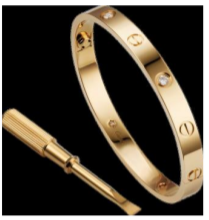Valentine’s Day Greetings
“Can anyone have a monopoly over love? More precisely, can a trader prevent other traders from registering a trade mark which includes the word ‘LOVE’ for use on jewellery?” These were the questions posed by a Hearing Officer a little over two years ago in this decision from Singapore.
Cartier, one of the leading global luxury goods companies, had a Singapore registration of the word LOVE (in stylized form) for jewelry items. Its mark appeared with the letter “o” shaped like a slotted screw head, and with the “e” in lower-case unlike the other letters in that mark. (Cartier also has a registration of this mark in the United States and has been vigilant in opposing marks it considers confusingly similar).

The slotted screw head relates to Cartier’s “Love” collection bracelet, which can only be removed using a screwdriver sold with the bracelet. That bracelet is sometimes referred to as “modern love handcuffs” and is intended to symbolize the attachment between two parties.

Cartier opposed a Singapore application by MoneyMax, a leading pawnshop chain in Singapore and Malaysia, to register LOVE GOLD (in a different stylized form) for jewelry items and for retail services relating to jewelry. The MoneyMax mark displayed LOVE above GOLD next to Chinese characters which have no meaning.

The decision rejected the two grounds on which the opposition relied:
- Relative. Neither of the distinctive elements of Cartier’s mark (the slotted screw head and lower case “e”) was present in the MoneyMax mark so the two marks were not “similar.” The Hearing Officer noted that numerous other traders had registered a mark incorporating the word “LOVE” for jewelry, including
 , “LOVE & LOVE,” “Love Bridge,” “PERFECT LOVE” and many more.
, “LOVE & LOVE,” “Love Bridge,” “PERFECT LOVE” and many more. - Absolute. Even if the separate elements of the MoneyMax mark might lack distinctiveness, the combination of the Chinese words with the words “LOVE” and “GOLD” rendered that mark distinctive as a whole.
The Hearing Officer dismissed the opposition by stating, “A ![]() Bracelet may represent a metaphorical shackle of a person’s loved one. The word ‘LOVE’, however, should be free for traders to incorporate into their trade marks for jewellery.”
Bracelet may represent a metaphorical shackle of a person’s loved one. The word ‘LOVE’, however, should be free for traders to incorporate into their trade marks for jewellery.”
So “love” remains available for all, at least in the jewelry industry in Singapore.
MoneyMax Jewellery Pte. Ltd. (Applicant) v. Cartier International AG (Opponent), Opposition against Application No. 4.”0201701277U, [2018] SGIPOS 22 (Hearings and Mediation Dept. of the Intellectual Property Office of Singapore December 20, 2018).
You may have noticed that the Singapore opinion used the British spelling of “trade mark” and ”jewellery” rather than the American spelling of “trademark” and “jewelry.” The word “love,” however, is spelled consistently throughout the modern English-speaking world, although some have used the nonstandard spelling “luv.” However you spell it, we send you our best wishes for love and all other good things on this Valentine’s Day and beyond.
For further information, please contact William M. Borchard or your CLL attorney.

Counsel
Email | 212.790.9290
Bill advises on domestic and international trademark matters at the highest level. His practice consists of counseling clients and handling domestic and international trademark and copyright matters including clearance, registration, proper use, licensing, contested administrative proceedings and infringement claims.